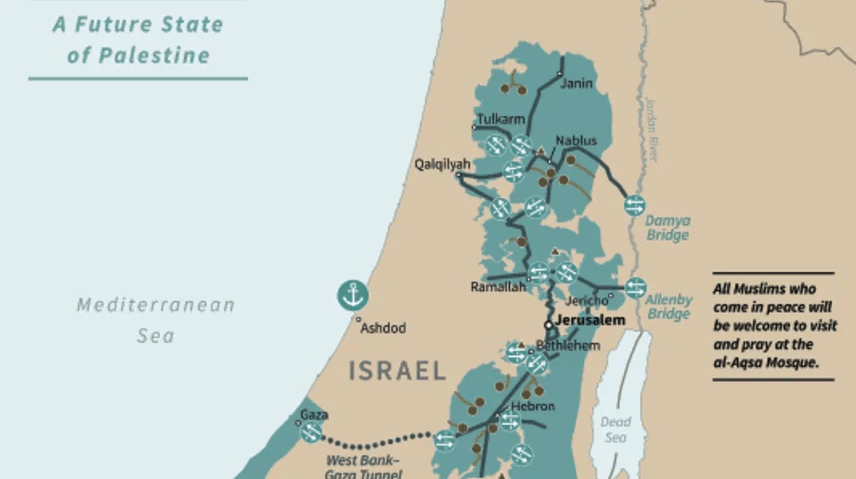At a first glance, Donald Trump’s proposed peace agreement between the Israelis and the Palestinians, officially titled Peace to Prosperity, appears positive. For decades, successive US Presidents have claimed to support the two-state solution to the conflict, which would entail both Israel and Palestine being recognised as states, each with their own government, clearly defined borders and a place at the United Nations. The current situation sees Israel as a recognised state, but the Palestinians continue to be one of the most widely known examples of a stateless people. Despite claiming to support this policy, no US President until Donald Trump has actually proposed a concrete peace deal which would oversee the creation of a Palestinian state with a capital in East Jerusalem, and contain a detailed plan as to how to achieve this. President Trump and Israeli Prime Minister Benjamin Netanyahu have described the agreement as the “deal of the century” and a “win-win opportunity for both sides.”

However, there remains one central problem with Trump’s proposed deal – the fact that the Palestinians were not consulted at all. The only parties to this deal have been the United States and Israel, and, as expected, the deal is still heavily biased towards the Israeli side. For the Palestinians, this deal is not a “win-win” as President Trump has claimed. The most contentious issues with regards to the Israeli-Palestinian peace process have been the status of Palestinian refugees, the construction of illegal Israeli settlements in the West Bank, the symbolism of Jerusalem and the fact that the Palestinian territories of the Gaza Strip and the West Bank are located on opposite sides of Israeli territory, the borders of which are also highly disputed. President Trump has put forward the idea of a tunnel through Israeli territory which would link the two, which has been accepted by Israel. With regards to problems of settlements and Jerusalem’s status, though, the Israelis come out on top. Following the 1967 Six Day War, in which Israel defeated the combined forces of Egypt, Jordan and Syria, Israeli civilians have built settlements in the territories of the West Bank which were occupied by their nation’s troops.
Despite the United Nations deeming these settlements illegal, Donald Trump’s peace agreement recognises these settlements as being an integral part of Israeli territory. Immediately after Trump’s announcement of the agreement, Netanyahu announced that Israel will be annexing the West Bank settlements as well as the Jordan Valley. Although the deal does also contain the clause that Israel should freeze any further settlement building, this is only conditional for four years. Once this time period has elapsed, the Israelis will be free to begin construction once again. This is completely unacceptable to the Palestinian side, as it legitimises one of the things they have fighting against for decades – further Israeli expansion into their land. The Palestinians, as well as many other actors on the international stage, including activists around the world, would rather see Israel’s borders be scaled back to what they were prior to the 1967 war or even further back to what they were in 1948. Further fuelling the anger is the fact that Palestinian refugees, who number around 5 million and are spread throughout the region, are also denied the right to return to their former homes in Israel without Israeli approval.

The agreement will see Palestine getting its own capital in East Jerusalem, but again the Palestinians feel they have been given the short end of the stick. The area of “East Jerusalem” which will form the Palestinian capital is in actuality a handful of grim neighbourhoods which have been described variously as “slums” and “gang-ridden”, and are in many cases separated by Israeli communities and road networks. The status of Jerusalem has long been a central issue to the peace process, as the city contains Holy Sites which are hugely symbolically important to Jews, Muslims and Christians alike. Under President Trump’s agreement the Temple Mount, on which the third holiest site in Islam, the Al-Aqsa Mosque, is built, will be within Israeli territory. When President Trump first began to address the issue of the decades-old Israel-Palestine conflict in 2017, he promised to bring fresh ideas to the table and stated that “both sides will have to compromise.” Upon meeting the US Commander-In-Chief for the first time, Palestinian President Mahmoud Abbas praised him by saying “with you we have hope.”
The deal President Trump has crafted has undone all of this, and it appears it is solely the Palestinians who have had to compromise whilst the hardliners in Israel have had to give up nothing. Abbas has condemned the deal, and Palestinians have taken to the streets to protest, setting fire to the American flag. The whole affair is part of an increasingly volatile foreign policy towards the Middle East by the Trump administration. When elected in 2016, Trump appeared to embrace a policy of near isolationism, calling for an end to US interventions in other countries. Although he has overseen the withdrawal of troops from Syria – which in itself was controversial, as it allowed Turkey to invade Syrian-Kurdish territory – this one-sided agreement, in addition to the escalation of tensions with Iran and continued military operations in Afghanistan, does not represent this kind of policy.
If you wish to respond to any of the issues discussed in this article, please contact editor@thegryphon.co.uk.
Image: Appendix 1, Peace To Prosperity (https://www.whitehouse.gov/peacetoprosperity/)

